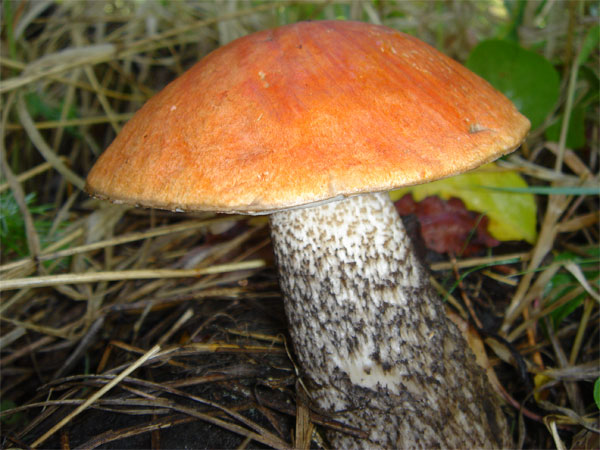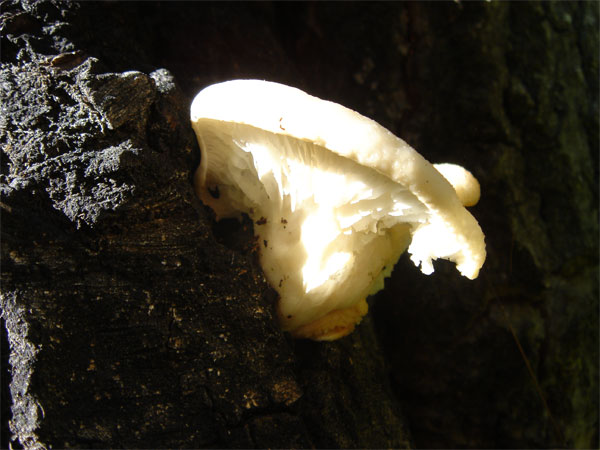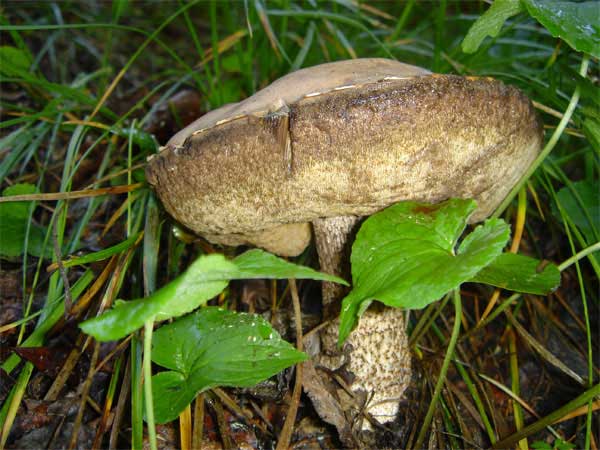Friday, July 22, 2005
Novice Mycophagist #2 “To Eat or Not to Eat”
Even though we spent 10 days at the cabin over the 4th of July week, it just wasn’t enough! So, we were back up there again the following weekend. We arrived in late afternoon on Thursday, and shortly after arriving we had a real downpour. Lightning, thunder, rain and hail. Altogether about 2/3 of an inch in less than an hour. The moisture was really needed. It was the first precipation in many weeks. The temperatures had been running in the high 80’s and low 90’s and it was getting really dry.
Of course, one of our first thoughts was “mushrooms!”.
On Friday morning, early, we took the dogs “around”. That is what we call our walk on the trail to the beaver pond and back—“around”. It was cool and wet and wonderful.
When we got to the bottom, near the beaver pond, I spotted a bright orange color poking out from under the long green grass. It was a young Aspen Orange Bolete, also known as an Orange Cap (Leccinum insigne). We photographed it and left it, but may harvest it for eating later. According to Vera Stucky Evenson’s book “Mushrooms of Colorado” there may be a variety of this edible mushroom that is poisonous, but yet unidentified. I’ve never eaten one.
This mushroom is easy to recognize with its almost perfect “mushroom” shape, its bright orange cap, the scabered stalk, and the fact that it is a bolete—with pores instead of gills on the underside.

Aspen Orange Caps grow prolifically on our land, although getting to them before the bugs do is often a challenge.
As we were kneeling to photograph the Orange Cap, I looked across Bart’s Creek and saw a bright white lump growing on a downed dead Aspen. Could it be? Sure enough, on close inspection it was the same kind of mushroom we lost last week to some scavanger who remains unidentified—probably a Pleurocybella porrigens or Angel Wings. It was small, but appeared to be mature. We didn’t harvest it at the moment (and by the next day it was too old).

A little further along the trail we saw another bolete. This one had a pale grey cap that was a little “slippery” where it was wet. It was about 4 inches in diameter. It appeared to be mature, although we had not seen it just 4 or 5 days earlier on our previous visit. It had a scabered stalk, yellowish pores, and did not stain when bruised or cut. The flesh was pale white. I picked it and took it home for identification.
We have quite a few books to aid us in identifying mushrooms. The two that I go to first are David Arora’s “All That the Rain Promises, and More…”, and the above referenced “Mushrooms of Colorado (and the Southern Rocky Mountains)” by Vera Stucky Evenson who works as the mycologist at the Denver Botanical Gardens (I think). We also have Arora’s authoritative “Mushrooms Demystified”, along with several less useful field guides (which seem to contain mushrooms found in Europe or the Eastern U.S. more than the Rocky Mountains.)
I immediately assumed the mushroom was some kind of Slippery Jack or Suillus. A few minutes later I was pretty sure what we had was a Suillus granulatus or Granulated Slippery Jack. I think most Suillus are edible, even though many don’t taste very good. So, we cleaned this one of its pores and I peeled most of the skin from the cap. Into the fridge it went. However, we never found a good opportunity to eat it.

So, over the weekend we found three nice, supposedly edible mushrooms, and we did not eat any of them! I really am a novice mycophagist!
Posted under: Mushroom Articles • by Rick on 07/22/2005 at 02:55 PM
Discuss this article • Permalink • eMail this article
Next entry: Novice Mycophagist #3 “The Oyster Tree”
Previous entry: Recipe Site Upgrade




